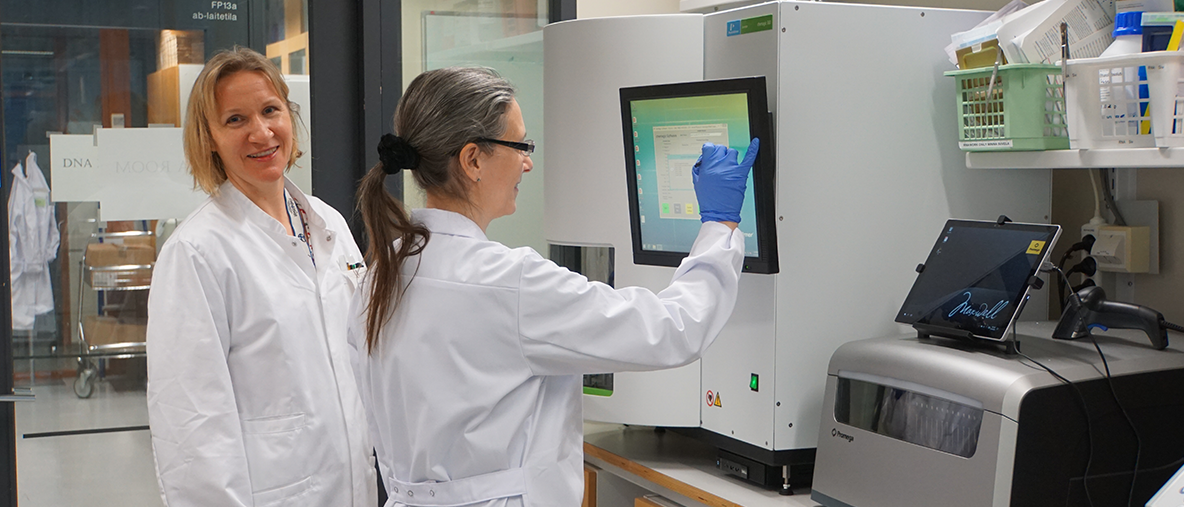Filling the methodological and knowledge gaps in extracellular vesicle research
Extracellular vesicles (EVs) isolated from easily accessible body fluids, such as urine and blood, can be of great diagnostic use. While EVs are attracting considerable interest in the scientific community, it has become evident that analysing them can be methodologically challenging. Recent findings from the EV team at FIMM help to direct the research and expedite standardization of the field.

Note: this article originally appeared on the FIMM website: https://www2.helsinki.fi/en/news/health-news/filling-the-methodological-and-knowledge-gaps-in-extracellular-vesicle-research
Extracellular vesicles are nano-sized membrane vesicles released by cells into the extracellular environment. EVs carry a diverse cargo of proteins, RNA and DNA, lipids, sugars and metabolites, and thus provide important information about the cellular state. They are involved in many physiological and pathological processes, such as immune response and cancer metastasis, and have a great potential to be important biomedical tools for diagnostic and treatment purposes.
To help researchers working in this field and to promote EV research at the University of Helsinki, a core unit providing EV infrastructure and services was established in 2016. For several years, the experts of this team have systematically developed methods for isolating, quantitating and analyzing EVs from various sources.
Dr. Maija Puhka, who leads the EV core services and related research projects at FIMM, has focused on studying liquid biopsy disease biomarkers, especially urinary EVs.
“The discovery of extracellular vesicles in urine opened a new fast-growing scientific field. In the last decade, urinary extracellular vesicles were shown to provide information of physiological and pathological conditions in urogenital system like kidney and prostate”, Dr. Puhka says.
Close attention to sample handling
The FIMM team has recently published several high-quality method development publications in the Journal of Extracellular Vesicles. In these publications, Dr. Puhka, FIMM PhD student Karina Barreiro, Dr. Om Dwivedi, Carol Forsblom, and Professors Harry Holthöfer,Tiinamaija Tuomi, Leif Groop and Per-Henrik Groop and their collegues studied the effect of EV isolation methods as well as storage temperature, time and format on the quality of urinary EVs.
Interest in uEV as a source for biomarkers has increased steadily in recent years. However, little is known about the effects of pre-analytical variables on urine and uEV cargo stability in the long term.
The researchers put special focus on comparing the effect of isolation methods and storage conditions on the preservation of the RNA content (the transcriptome) of EVs. RNA-samples isolated from the EVs were subjected to miRNA and RNA sequencing in collaboration with FIMM Technology Centre’s RNA sequencing unit, headed by Dr. Pirkko Mattila.
The study provides important information for biobanks and other stakeholders aiming to store EV samples for a longer time. The results demonstrate that urinary EVs and their transcriptome were preserved even after long-term storage at -80°C.
“However, storage at normal -20°C freezer temperatures is not a good idea – it degrades the RNAs, particularly the GC-rich parts of the transcriptome”, Dr. Puhka elucidates.
Another main conclusion was that the different isolation workflows enrich partially distinct EV preparation components, which may pose challenges when comparing the results between different studies. The team approached the problem by identifying 14 stable microRNAs between methods, which therefore hold potential as “housekeeping” normalizers in data analysis.
Translating the knowledge
So far, the FIMM EV researchers have utilized these methods in exploring the RNA-biomarker landscape for diabetic kidney disease as well as for prostate and kidney cancer. Recently, Dr. Puhka, Professor Antti Rannikko and collaborators published a study of EVs in clinical samples from prostate cancer patients demonstrating that urinary EV samples contain microRNAs regulating well-known and emerging cancer pathways.
”The microRNAs associated with prostate cancer status or progression appeared highly unique. We believe that EVs offer a useful liquid biopsy for tracking personalized cancer-associated changes.”
The EV core is currently developing its services further by setting up pipelines for improved sample throughput and analytical capacities. In addition to urine, method development regarding plasma EVs is ongoing.
The University of Helsinki EV core is a co-operated venture of the Faculty of Biological and Environmental Sciences (Viikki campus) and the Institute for Molecular Medicine Finland (FIMM) run by two EV-dedicated laboratories led by Dr. Pia Siljander and Dr. Puhka. As an academic research service facility, the EV core provides infrastructure, state-of-the-art and emerging EV-technologies for research groups, hospitals, companies and authorities in the EV-field. The EV core team leaders are also developing a novel biomarker discovery platform called FastEV.